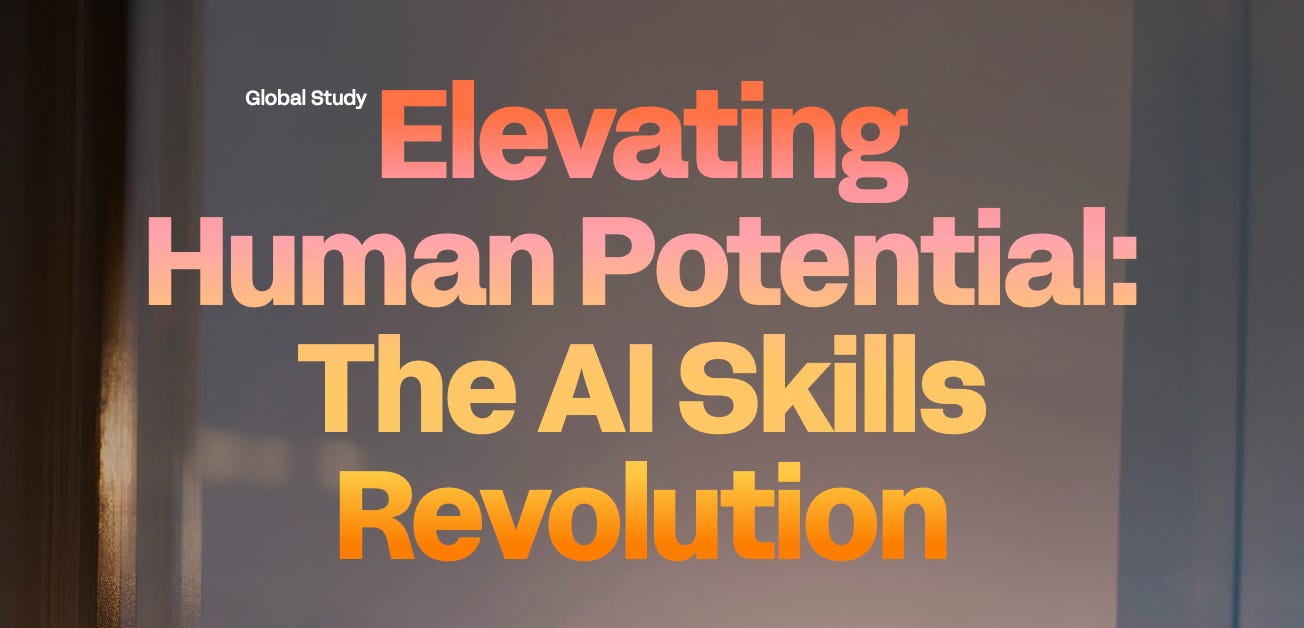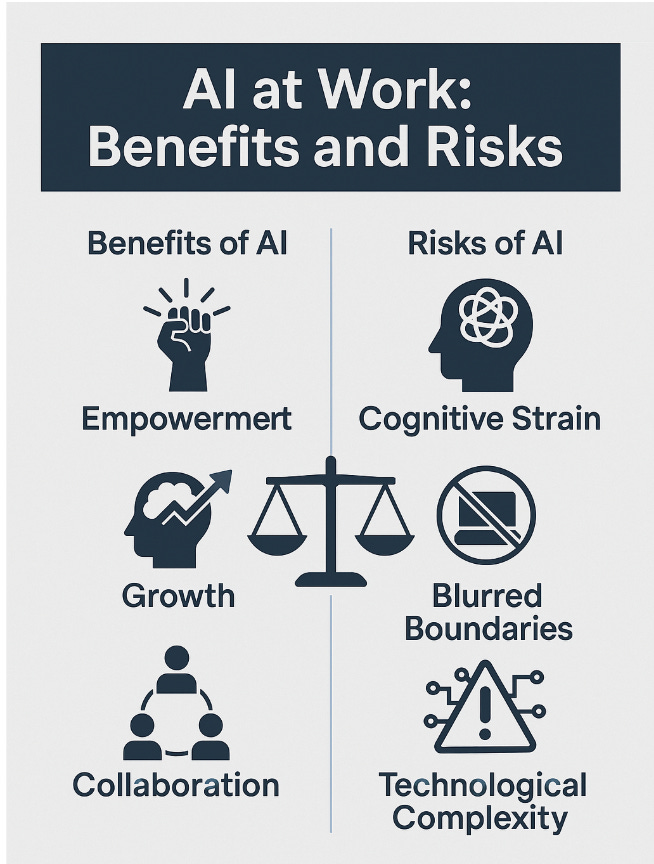The 2025 Davos Workday report, "Elevating Human Potential: The AI Skills Revolution," reads like a manifesto for a future in which AI doesn't replace humans—it reveals us.
Creativity, empathy, moral judgment, and adaptability emerge not as nice-to-haves but as survival skills in an increasingly automated world. And for once, the narrative isn’t fear-driven. It’s ambitious. Even hopeful.
Grounded in a global survey of 2,500 full-time workers across 22 countries, the report argues that five human-centric principles—Creativity, Leadership, Learning, Trust, and Collaboration—will define success in the AI era.
But there's another side of the coin that your inbox or next team meeting might show you more clearly than any white paper: AI-induced technostress.
While Workday focuses on how AI can free us from rote work and elevate our best human qualities, the report also implicitly outlines the psychological and organizational pressures of the AI revolution. If unmanaged, those pressures can become a systemic drag on productivity, mental health, and organizational trust.
Let’s unpack both the promise and the peril through the lens of the AI Technostress Framework: how technostress shows up, where it hides, and what organizations must do to transform stress into strength.
🚩 Technostress Trigger #1: Techno-Overload
The report reveals that 93% of AI users claim the technology enables them to focus on higher-level responsibilities, and 83% believe it enhances their creativity. That sounds great—until it doesn’t.
Why? Because the shift from doing tasks to managing systems that do the tasks isn’t stress-free. Offloading the "grunt work" sounds like liberation, but in practice it often looks like...
A flood of Slack alerts from AI-driven platforms
The pressure to review, correct, and approve AI-generated outputs faster than ever
A creeping sense that you must now be strategically creative 100% of the time
This is the core of techno-overload—not just information overload but expectation overload. AI may streamline the task, but it stretches the human.
Solution: Build in "digital decompression" protocols. Just as we learned to manage email overload, we now need guardrails for prompt reviews, chat-based collaboration, and GenAI feedback loops.
🚷 Technostress Trigger #2: Techno-Invasion
Workday emphasizes that employees "crave more human connection as AI usage grows." In fact, 82% of employees report this need—but only 65% of managers see it, a striking connection gap.
This disconnect highlights a second technostress driver: techno-invasion—the erosion of boundaries between human-centered work and algorithmic optimization.
AI is always on, and increasingly, so are we. Whether it's generating performance dashboards or learning modules, the line between being “off work” and simply “on call for insight” is blurring.
And that’s not just inconvenient—it’s depleting.
Solution: Organizations must champion digital boundaries as part of their AI deployment. If AI augments productivity, then leaders must actively safeguard human recovery time.
🤯 Technostress Trigger #3: Techno-Complexity
AI is not plug-and-play. The Workday study shows optimism among AI adopters—especially those already using it—and uncertainty among those just beginning. Three in five businesses are adopting AI, but only about 1% consider their adoption “mature,” leaving a wide skills gap.
That’s fertile ground for techno-complexity, the stress of constantly learning, unlearning, and relearning systems, protocols, and tools.
Workday calls for upskilling in areas like strategic planning, cultural adaptation, and ethical reasoning—soft skills, yes, but also deeply cognitive ones. The paradox? AI simplifies the task but complicates the system.
Solution: Treat learning as a collective infrastructure, not an individual burden. Embed peer learning, micro-training, and real-time support into AI workflows, not just HR portals.
😰 Technostress Trigger #4: Techno-Uncertainty
The report celebrates AI’s power to increase transparency and trust, with 90% of respondents agreeing AI can enhance accountability. But buried in that optimism is a quieter fear: job displacement.
While it’s framed as cultural anxiety, this fear creates techno-uncertainty—the chronic unease about what's next. Will AI change your role? Will you need new skills? Will your value be measured differently?
These aren’t questions you can solve with a dashboard. They require emotional intelligence, clarity from leadership, and honest conversations about the pace of change.
Solution: Normalize uncertainty. Offer scenario-based planning sessions, not just for strategy but for employees to envision multiple futures where they still belong.
🔒 Technostress Trigger #5: Techno-Insecurity
Finally, we reach the deepest cut: techno-insecurity—the fear of being made obsolete. Despite Workday’s best efforts to elevate soft skills like relationship-building and empathy, employees may still interpret AI’s rise as their fall.
Especially if performance reviews or promotions start to factor in “AI utilization” as a metric.
Yes, AI can free up time for more strategic work. But what if no one told you how to be more strategic? What if no one coached you on how to turn AI outputs into your insights?
Solution: Align AI deployment with human coaching, not just tool training. Give people frameworks for strategic thinking, not just access to automation tools.
🔁 Turning Technostress Into Technotransformation
If you’re an HR leader, a department head, or a C-suite executive, the Workday report gives you both a vision and a warning. AI can elevate human potential, but only if you manage the new pressures it creates.
Here’s how you can start:
Acknowledge the strain—Technostress is real. Pretending it's not won’t make your team more adaptive.
Run a Technostress Audit—Gauge how AI is impacting your employees' mental bandwidth, not just their productivity metrics.
Create Technostress Action Plans—These should be tied to principles like leadership, trust, collaboration, and learning (just like Workday suggests).
Build your AI rollout on wellbeing, not just ROI.
As I am fond of saying, integrating AI into the workplace isn’t just about the technology; it’s also about taking care of people along the way.
📈 The Real Skills Revolution
Workday is right: AI isn’t about replacing human potential—it’s about revealing it.
But if we want to elevate that potential, we must clear the path of digital clutter, psychological strain, and silent burnout. That means shifting the narrative from AI as a productivity engine to AI as a partner for well-being.
As Workday VP of AI Kathy Pham put it, AI is helping us “find the right words [and] bridge cultures”—tools that paradoxically make us more human.
That’s the true skills revolution. And it starts with trust, empathy, and a little less noise.
Got some thoughts about this topic? Please leave a comment and keep the conversation going.
AI Workplace Ethics & Wellness is the official publication of the AI Technostress Institute. Our goal is to help teams thrive in an AI-driven workplace. Learn more »





Muy interesante cómo la IA puede ayudar a prevenir el estrés laboral. En España, he visto que pequeñas intervenciones como pausas activas y organización de tareas según riesgo psicosocial tienen un gran impacto en la productividad y el bienestar del equipo. Gracias por compartir estas ideas. Aqui escribo sobre el bienestar laboral en España- https://www.puntodequilibrio.es/
Digital boundaries...I didn't use the term. But recently, I had to set them. Nice to see a term I can connect with. I'm still learning the boundaries to set in my life...it's complicated LOL.
But adding digital boundaries to the list.